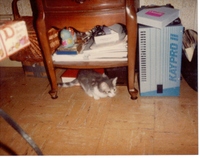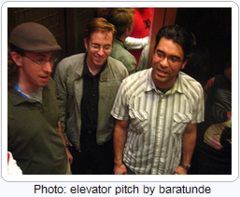Think of this as Volume 11, Number 16 of A-Clue.com, the online newsletter I’ve written since 1997. Enjoy.
My health is good. We’re happy. But there are days when I do wish I were 30 years younger, full of piss-and-vinegar.
Days like today.
Because if I were 28 again, and just starting out, this is the kind of business plan I would dearly love to implement. It’s what I dreamed of when I first put "Have Modem, Will Travel" on my business cards over 25 years ago. (The picture is from that time. That’s my old Kaypro II on the right. The kitten, LoMeow, lived to the age of 18.)
I call it the Community Server, and it’s designed to activate rural communities and the back-end of the Internet revolution, the people who right now are either off-line or turned off by what they see online.
Let’s start with some facts. Many types of demand can be aggregated and delivered at low cost. Not just diapers and TVs, as Wal-Mart did. Not just electricity as co-ops have for years. But telecommunications as well.
I’ve described over the years how cheaply WiFi can be delivered, and how copper wires can be transformed by going all-digital. But now that you’ve got people an on-ramp, where are they going?
To a directory, first of all. City directories and phone directories. Get the data and put it online.
Build a database of it, with each listing a virtual page. The front-end can be Elgg, it can be Marc Canter’s PeopleAggregator, it can be Drupal, or (here’s a good idea) it can be WordPress.
Take your time selecting the platform, because it’s an important choice. You want to be able to add the capabilities of sites like FaceBook, YouTube, and MySpace, as your users demand them. Few users will demand many of these new features right off — most will be happy with a blog — but when they’re ready you need to be ready. And your platform choice will determine that readiness. You’re looking for an open source platform with an active community and a real business behind it.
Your community server could be hosted in your service area, but it doesn’t have to be. If you’ve already aggregated Internet connectivity it might be fun to host it yourself. Otherwise leave it to the pros, and get near a major Internet Exchange. In time you’ll be the cloud. For now get next to one.
So far I haven’t really told you much. Anyone can do this. Many people do and wind up with empty servers. I’ve done it myself.
What’s the secret sauce?
The secret sauce is a business model which takes the best of old-line magazine publishing and the new reality of Web publishing. This starts with understanding the basic function of any journalist — to organize and advocate a location, industry or lifestyle.
The best of old-line publishing is the old magazine funding assumption. That is, you’re going to lose big the first year, lose a little the second year, break even the third, then head toward profit. You need a solid store of capital, enough to make a splash. Is $10 million too much to ask? Put half in the first year, hold the other half for the second and the third.
Now you’re going to start by hiring two key people, an editor and a publisher.
- The editor is the public face of the site. Someone who gives good quote, who has credibility, who’s curmudgeonly, and who likes working with young people.
- The publisher is the business force of the site. Someone who can schmooze the Chambers of Commerce, who knows spreadsheets and business planning, who really likes to sell.
The editor and publisher will build the staff based on the following compensation model.
- The editor’s people will be compensated every month based on the number of page views and responses their work gets. The aim is to give the writer one-fourth of the revenue from everything they do.
- The publisher’s people will be compensated every month based on the revenue their ads generate. You back that percentage off based on the age of the ad. Say half the take for three months, then a third, then a quarter, but even after years they’re still taking 20%.
Now you’ve put half your money into sales and content, a huge percentage in the journalism game. The rest goes to overhead and operations and (best of all) profit.
What do you charge? Display ads generate revenue each time they’re seen on a page, but you charge more for clickthroughs, for completed forms, and since your back-end has a cash register you can get a cut of sales as well. Text ads are priced solely based on clickthroughs, with a kill fee when the good or service in question is sold and the ad canceled.
The staff which joins the editor will draw interest based on the journalism they do. The staff which joins the publisher will be contacting everyone in the directory, seeking not just their money but their time. Do a tour of regional journalism and business schools to build your staff. Tell them it’s a great place to start.
It’s time that builds a site. Not your time, not your staff’s time, the time of your users. Let’s use the example of a local car mechanic.
Start with the time used to take that ad you’ve been running in the local newspaper for years and putting it online. Then when the mechanic goes in to check on it, maybe they blog a little about what’s happening. (Once they post the ad, they become a page administrator and can see how often it’s been viewed.) Or they get a camera and show off a car they have for sale, or shade tree mechanic skills.
Everything they build is free. No charge to get that old ad into your directory. No charge for posting the blog or the video. No charge for chatting on the phone with your rep. (The rep will want to connect the mechanic to others doing the same thing, creating a user group which might meet over coffee some morning, or over beers in the evening.)
But you can offer added features. How about a "fax link" so if someone wants to contact the shop you get a print-out right on the floor? Or a "chat" feature which jingles whoever might be in the office when someone wants to make an appointment and drop their car off. That you can charge for. But you don’t have to charge much. Once they’ve had some success you go in for the kill – a display ad that runs on others’ pages. Text ads when you’ve got a car to sell, or a special you want to run.
When the rep has had some success, then you call in editorial. There’s got to be some stories there, and the reporter just walks in and listens. He gets to know these people, and tells them what other resources might be available for them –not just on the Community Server but all over the Internet.
You do the same thing with white pages. Everybody has a listing, every single family. Every institution has a listing. Every club — charitable, social, church, whatever — can have a listing, and the offer of free space. If someone has a home page, or a blog, or a Web site of their own, and doesn’t want the free space you’re offering, link to what they do have. But stay in touch. Let them know how much traffic you’re throwing at them. Suggest that with an ad they would get more.
Everything grows organically. Whatever anyone does within the Community Server builds on what is already there. The idea is to slowly integrate use of the Internet, as both a creator and a searcher, as a writer and reader, into the lives of everyone you can. Old, young, rich, poor.
As you start generating traffic you can donate PCs to the local library, with Web access and your Community Server as the home page. You can donate the time of both employees and users to helping people get value from that PC, so it’s not sitting in a corner with some homeless guy looking for porn. You can do the same thing in City Hall, and urge your business customers to offer free WiFi at their shops as well.
As a business proposition most people in the Internet space make the mistake of thinking they’re running servers. What we’ve learned over the last decade is that successful businesses are building communities. (That’s the elevator pitch, picture from DumbLittleMan.)
Any virtual community, just like any real community, will be filled with people and talent waiting to be discovered. By connecting people together you can tease these talents out. You can take the back-end of the Internet revolution and not only get it online, but activate it, training people to get the most from the resource. As you do this you build human capital which other investors can take advantage of.
Everything you need to do this now exists. The low-cost bandwidth, the dirt cheap server storage, the open source software where you can scale the intimacy. Sure you’re going to replace some things, like the local newspaper and the printed phone book, but let them have some space, and charge them a usage fee which they can make up with their own ads, using your tools. Chances are they’ll say "thanks, but no thanks" and you link to them. Then watch them die, and their best people join you.
We’re used to Internet businesses just taking off, going from zero to infinity in a matter of months. This isn’t like that. Organic communities like these grow organically. You water it, you fertilize it, and you will accept "no" as an answer from the vast majority of citizens for quite some time.
But with patience your community will water the real community, and there’s nothing more gratifying than running a small newspaper. Online or off.
















i think this is such a great idea. people need the internet in the rural communities.
i think this is such a great idea. people need the internet in the rural communities.